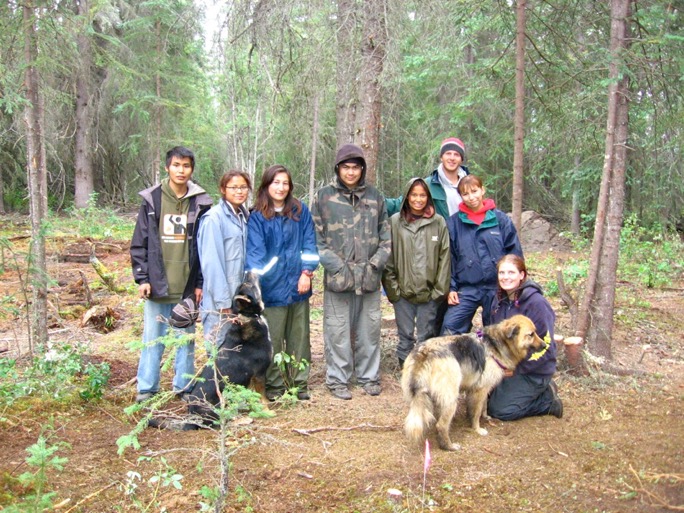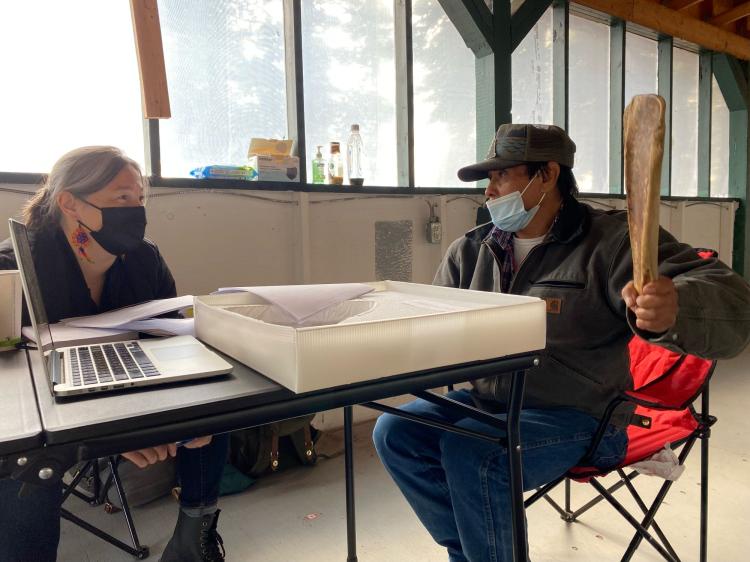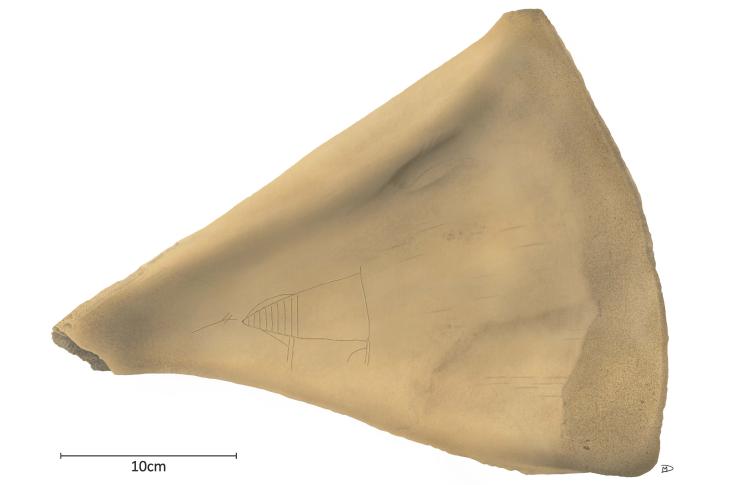Yukon University's Associate Professor of Anthropology in the School of Liberal Arts, Victoria Castillo, recently published an article in the peer reviewed journal Ethnohistory shedding new light on mid-19th century First Nations hunting practices in subarctic Canada.

Some of the 2006 Fort Selkirk Field Crew (left to right): Curtis Joe, Dayna Joe, Good Looking Collie (the husky), Victoria Castillo, Delaney Alfred, Lyndelle Johnson, Morgan Ritchie, Lauren McGinty, Sam Darling, Lala (the dog). Photo Courtesy of Victoria Castillo and Yukon Government.
Fort Selkirk, Yukon, served as a significant site of interaction between the Northern Tutchone people and Hudson's Bay Company fur traders during the mid-nineteenth century. In 2006, archaeological excavations at the site led to the recovery of a distinctive moose (Alces alces) scapula. This artifact offers material evidence of early contact period Northern Tutchone hunting techniques and scapulimancy. Etched into the surface of the bone is a detailed zoomorphic image of a large male ungulate, likely a moose, accompanied by an arrow in flight near its head.
To better understand the cultural and historical significance of the artifact, Dr. Castillo conducted an in-depth interview with Selkirk First Nation (Northern Tutchone) Elder Mr. Roger Alfred. Elder Alfred shared insights into the scapula's construction, its traditional uses, and the possible interpretations of the etching. By combining oral ethnoarchaeological knowledge with ethnohistorical research, the article, Calling Moose: A Mid-Nineteenth-Century Example of Northern Tutchone Scapulimancy from Fort Selkirk, Yukon, provides a holistic view of Indigenous moose hunting practices in the North American subarctic.
"Not every day does work at an archaeological site end with such a culturally iconic and cherished discovery," said Christian Thomas, Special Projects Archaeologist with the Yukon Government. "Since it was recovered, this hunting tool has stirred the imaginations of those who've had the opportunity to visit it, spurring many stories and teachings about moose hunting. What Roger Alfred and Victoria Castillo have perfectly brought forward in the conversation is the intersection of traditional ecological knowledge, artifact design, and spirituality in Indigenous hunting practice. This paper evokes an authentic sense of culture in its examination an everyday object, adding rare depth to the archaeological literature of the Yukon."

Mr. Roger Alfred demonstrating the scapula's use to Victoria Castillo. Photo Courtesy of Roman Zazula.
The Fort Selkirk scapula is a tangible testament to early hunting practises, offering compelling evidence of how Indigenous hunters understood and interacted with their environment long before written records.
"What Roger Alfred and Victoria Castillo share in this paper reminds us that even a simple tool like this moose scapula holds deep meaning," said Sharon Nelson, Selkirk First Nation Chief. "The etched figure reflects the deep connection our people have with the moose and the land. These are not just markings but symbols with important cultural significance. Tools like this were crafted with care and guided by generations of knowledge passed through lived experience. For our citizens, and especially our youth, this is more than a historical object. It represents a tangible link to the central role of hunting and traditional practices in the life of our community."
This research was supported in part by SAG funding, and sections are drawn from the author's 2012 PhD dissertation, Fort Selkirk: Early Contact Period Archaeology, published by the Yukon Government. The full dissertation can be accessed in the Related content section of this release.
Importantly, this work also involved Selkirk First Nation students, who participated in archaeological excavations over a three-year period ensuring that research and education remain grounded in community.

Etched into the surface of the bone is a detailed zoomorphic image of a large male ungulate, likely a moose, accompanied by an arrow in flight near its head.
Acknowledgements
Special recognition is given to the late Elder Mr. Roger Alfred, the Selkirk First Nation, and the Yukon Government Heritage Branch for their invaluable contributions and support.












